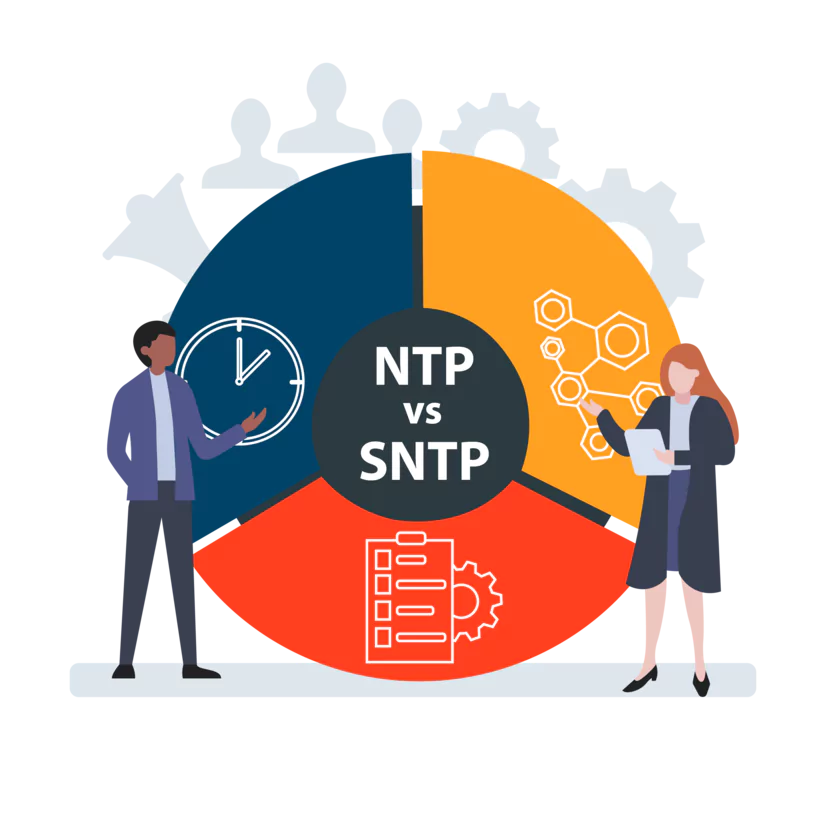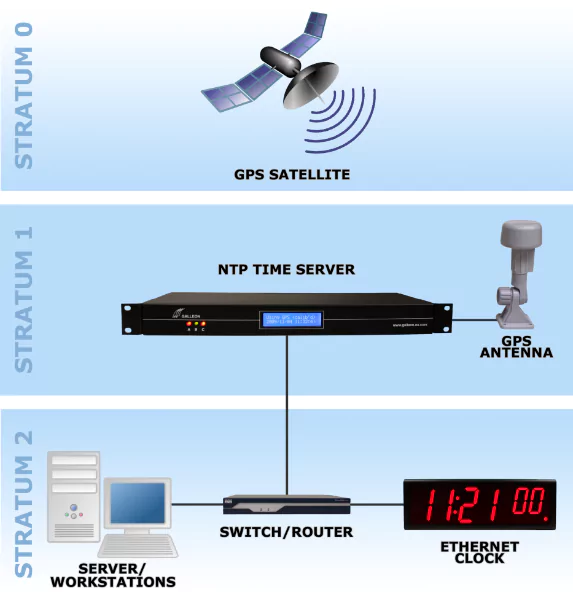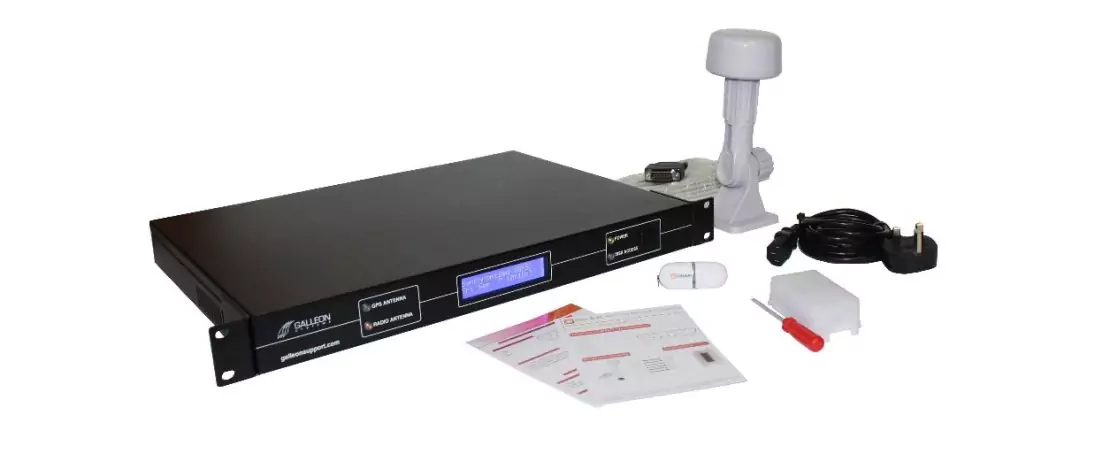The difference between NTP and SNTP is in the way each one checks and corrects the time. NTP continually checks the time on your devices against the time provided by your server, but SNTP only checks at set intervals. Between these intervals, SNTP devices can drift out of sync. That makes NTP the better choice for organisations that depend on precise time for their critical systems.

What’s the difference between NTP and SNTP?
Should you choose NTP or SNTP?
How can you get started with synchronised time?
Contact Galleon Systems for more information
What’s The Difference Between NTP And SNTP?

Network time protocol (NTP) and simple network time protocol (SNTP) are two similar ways of synchronising your devices to Coordinated Universal Time (UTC).
The basic setup is the same for both. A radio or GPS atomic clock signal (stratum 0 in the above picture) sends precise time to a NTP time server (stratum 1). The server then sends that time to the devices on your network, known as clients (stratum 2).
You benefit from synchronised IP clocks, phones, computers and more throughout your organisation.
The main difference between NTP and SNTP is in how and when your clients correct themselves to stay in sync with UTC.
NTP uses complex algorithms that allow clients to make smooth, real-time adjustments that keep them permanently synchronised.
This involves the continuous swapping of timestamps between your clients and your server:
- The client sends a timestamp to the server, which could be up to 100ms out.
- The server then sends a timestamp back to the client, which could up to 80ms out.
- NTP will then add these values together, divide by two and adjust by 90ms to show the correct time on the client.
This non-stop process of adjustment is known as time skewing, and it’s highly effective at keeping clients and servers in sync.
But SNTP uses a simplified method of adjustment, known as time stepping. This involves the server ‘shouting’ the time at the client at the same time each day. The client then jumps its time forwards or backwards to match. However, the time sent by the server can be up to 100ms out, and SNTP devices can drift even further out of sync between each interval.
Think of it like this: NTP is like an employee whose only job is to watch two clocks and make continuous changes to keep them synchronised. SNTP is like an employee tasked with checking the time between two clocks once a day and making one big adjustment at that point.
The first employee’s clock will be more accurate, but the resources needed to have a dedicated person to do this are greater. The second employee’s clock could drift out of sync over the course of each day, but it’s a simpler way of doing things.
However, SNTP can also cause problems if other devices, like network switches, get added in. These communicate in SNTP, often without the sysadmin’s knowledge. In this situation, you can have multiple devices ‘shouting’ different times to clients. Clients will then jump between different times throughout the day, making them even further out of sync.
These time discrepancies can cause critical issues for automated network tasks and when backing up NTP servers.
There are a couple of other differences between NTP and SNTP:
- NTP can use multiple time servers to keep the system synchronised, but SNTP is based on a single time server. Extra servers can be used as back-ups, but SNTP can’t communicate with multiple servers to work out which one is the most accurate.
- NTP has extra security features, like secure client-server authentication. Most SNTP clients don’t have this, which makes them vulnerable to timestamp spoofing.
Should You Choose NTP Or SNTP?

The difference between NTP and SNTP is small but significant. In practice, NTP is almost always the better option.
SNTP was released in the 1990s to suit the limited processing power of the day. But modern computers are more than capable of running NTP, so there are few reasons not to use it.
You might still choose SNTP for devices on the periphery of your network, like phones, network clocks, and other devices that are less critical. This can make things simpler, and you might decide it’s all you need.
For example, if you want to synchronise the clocks in a few different offices so everyone comes to the weekly meeting on time, then SNTP will be just fine. You won’t notice when your clients step time to correct themselves, and no one will be able to blame a slow clock again.
But SNTP isn’t suitable for applications where the exact order of events is important. In financial services, for instance, if the time on a client was stepped back or forward between two transactions, they could appear in the wrong order.
So, it all depends on your business needs. But NTP is usually the best option — it’s more accurate, more secure and well within the capabilities of the average computer.
Still not sure? Contact Galleon Systems for free advice on choosing NTP or SNTP for your organisation.
How Can You Get Started With Synchronised Time?

You can get the benefits of synchronised time in any business or organisation. The heart of your setup will be your time server:
- The NTS-4000 synchronises a single network, so it’s ideal for small to medium businesses.
- The NTS-6002 can synchronise two networks at the same time, making it a great choice if you have separate staff and customer networks.
- For the biggest businesses, the NTS-8000 can synchronise devices on up to six networks at once.
Each of these servers can synchronise thousands of devices. You can set them up to get atomic clock time from a radio or GPS source — or both! Just ask for the right antenna when you place your order. You can run them on any operating system, and they integrate easily alongside your existing hardware in a 19” rack.
For a complete solution, pair your time server with easy-to-read wall NTP clocks for offices, warehouses, schools, hospitals and more.
Contact Galleon Systems For More Information
Galleon Systems has over 20 years’ experience manufacturing time servers, clocks and software for customers like Vodafone, Ford and HSBC.
Get in touch for a no-obligation chat about the differences between NTP and SNTP.
Fill in a contact form or call 0121 608 7230 for help choosing the right one for you.




